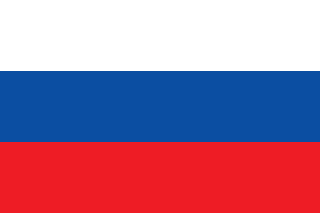
The Army of the Czech Republic, also known as the Czech Army or Czech Armed Forces, is the military service responsible for the defence of the Czech Republic in compliance with international obligations and treaties on collective defence. It is also set to support peacekeeping, rescue and humanitarian operations both within the national territory and abroad. Armed Forces consist of the General Staff, the Land Forces, the Air Force and support units.

The Armed Forces of the Slovak Republic were divided from Czechoslovak army after dissolution of Czechoslovakia on January 1, 1993. Slovakia joined NATO on 29 March 2004. From 2006 the army transformed into a fully professional organization and compulsory military service was abolished. Slovak armed forces numbered 15,996 uniformed personnel and 3,761 civilians in 2014.

Carpatho-Ukraine or Carpathian Ukraine was an autonomous region within the Second Czechoslovak Republic, created in December 1938 by renaming Subcarpathian Rus which full administrative and political autonomy was confirmed by the Constitutional law of 22 November 1938. After the breakup of the Second Czechoslovak Republic, it was proclaimed an independent republic on 15 March 1939, headed by president Avgustyn Voloshyn, who appealed to the Axis powers for recognition and support. Nazi Germany did not reply, and the short-lived state was occupied and annexed by the Kingdom of Hungary, crushing all local resistance by 18 March 1939.

The President of the Slovak Republic is the head of state of Slovakia and the commander-in-chief of the Armed Forces. The president is directly elected by the people for five years, and can be elected for a maximum of two consecutive terms. The presidency is largely a ceremonial office, but the president does exercise certain limited powers with absolute discretion. The president's official residence is the Grassalkovich Palace in Bratislava.
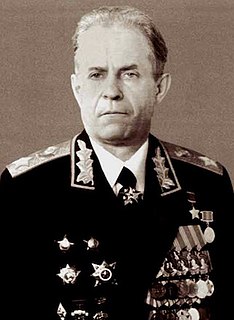
Sergey Fyodorovich Akhromeyev was a Soviet military figure, Hero of the Soviet Union (1982) and Marshal of the Soviet Union (1983).
Authorized foreign decorations of the United States military are those military decorations which have been approved for wear by members of the United States armed forces but whose awarding authority is the government of a country other than the United States.

Sergey Leonidovich Sokolov was a Soviet military commander, Hero of the Soviet Union, and served as Minister of Defence of the Soviet Union from 22 December 1984 until 30 May 1987.
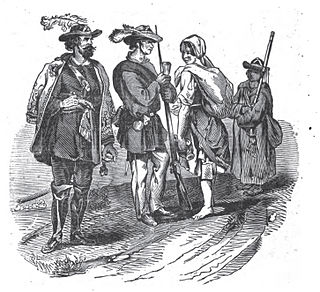
A military volunteer is a person who enlists in military service by free will, and is not a mercenary or a foreign legionnaire. Volunteers often enlist to fight in the armed forces of a foreign country. Military volunteers are essential for the operation of volunteer militaries.

During World War II, the Kingdom of Hungary was a member of the Axis powers. In the 1930s, the Kingdom of Hungary relied on increased trade with Fascist Italy and Nazi Germany to pull itself out of the Great Depression. Hungarian politics and foreign policy had become more stridently nationalistic by 1938, and Hungary adopted an irredentist policy similar to Germany's, attempting to incorporate ethnic Hungarian areas in neighboring countries into Hungary. Hungary benefited territorially from its relationship with the Axis. Settlements were negotiated regarding territorial disputes with the Czechoslovak Republic, the Slovak Republic, and the Kingdom of Romania. In 1940, under pressure from Germany, Hungary joined the Axis powers. The following year, Hungarian forces participated in the invasion of Yugoslavia and the invasion of the Soviet Union. Their participation was noted by German observers for its particular cruelty, with occupied peoples subjected to arbitrary violence. Hungarian volunteers were sometimes referred to as engaging in "murder tourism."
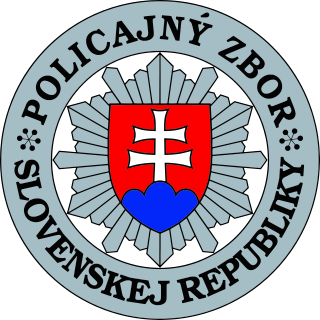
Law enforcement in Slovakia is divided among various agencies under the Slovak ministries of Interior, Justice, Traffic, Defense, Finance and local governments within the Republic. The Slovak Secret Service, one out of four secret services in the country, also lists among its tasks those usually reserved for the police force, for example fighting against organized crime and computer crime, Slovakia also features voluntary police without any extra rights.

Rugby union in Czechoslovakia was a moderately popular sport. It was most popular in Moravia, Prague and Bratislava

The Tatrapan is an 6x6 special military vehicle produced by the Slovak defence industry company VYVOJ Martin Developed for various utilization by Slovak armed forces as well as export purposes.

The Military Ordinariate of Slovakia is a Latin military ordinariate (pseudo-diocese) of the Roman Catholic Church for the Slovak armed forces.

Public Security was the regular police force of the Czechoslovak Socialist Republic (ČSSR), created in 1945 as a department of the National Security Corps, which also included State Security, Armed Airport Security ) and Armed Railway Security,.
Orders, decorations, and medals of Turkey are civil and military state decorations regulated and bestowed by the Turkish Republic.

The Slovak Uprising , Slovak Volunteer Campaigns or Slovak Revolt was an uprising of Slovaks against the Hungarian rule in Western parts of Upper Hungary, within the 1848–49 revolutions in the Habsburg Monarchy. It lasted from September 1848 to November 1849.
The Chief of the General Staff of Czechoslovakia refers to the Chief of the General Staff of the Czechoslovak Army and the Czechoslovak People's Army, from the creation of the First Czechoslovak Republic in 1918 until the dissolution of the Czech and Slovak Federative Republic in 1992.

The Chief of the General Staff is the Chief of the General Staff of the Slovak Armed Forces. He is appointed by the President of Slovakia, who is the commander-in-chief. The current Chief of the General Staff is Lieutenant General Daniel Zmeko.
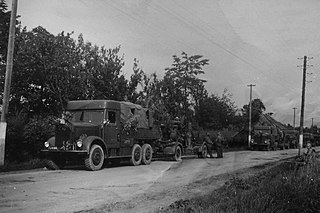
The Slovak National Uprising or 1944 Uprising was an armed insurrection organized by the Slovak resistance movement during World War II. This resistance movement was represented mainly by the members of the Democratic Party, but also by social democrats and Communists, albeit on a smaller scale. It was launched on 29 August 1944 from Banská Bystrica in an attempt to resist German troops that had occupied Slovak territory and to overthrow the collaborationist government of Jozef Tiso. Although the resistance was largely defeated by German forces, guerrilla operations continued until the Soviet Army, Czechoslovak Army and Romanian Army liberated Fascist Slovakia in 1945.

